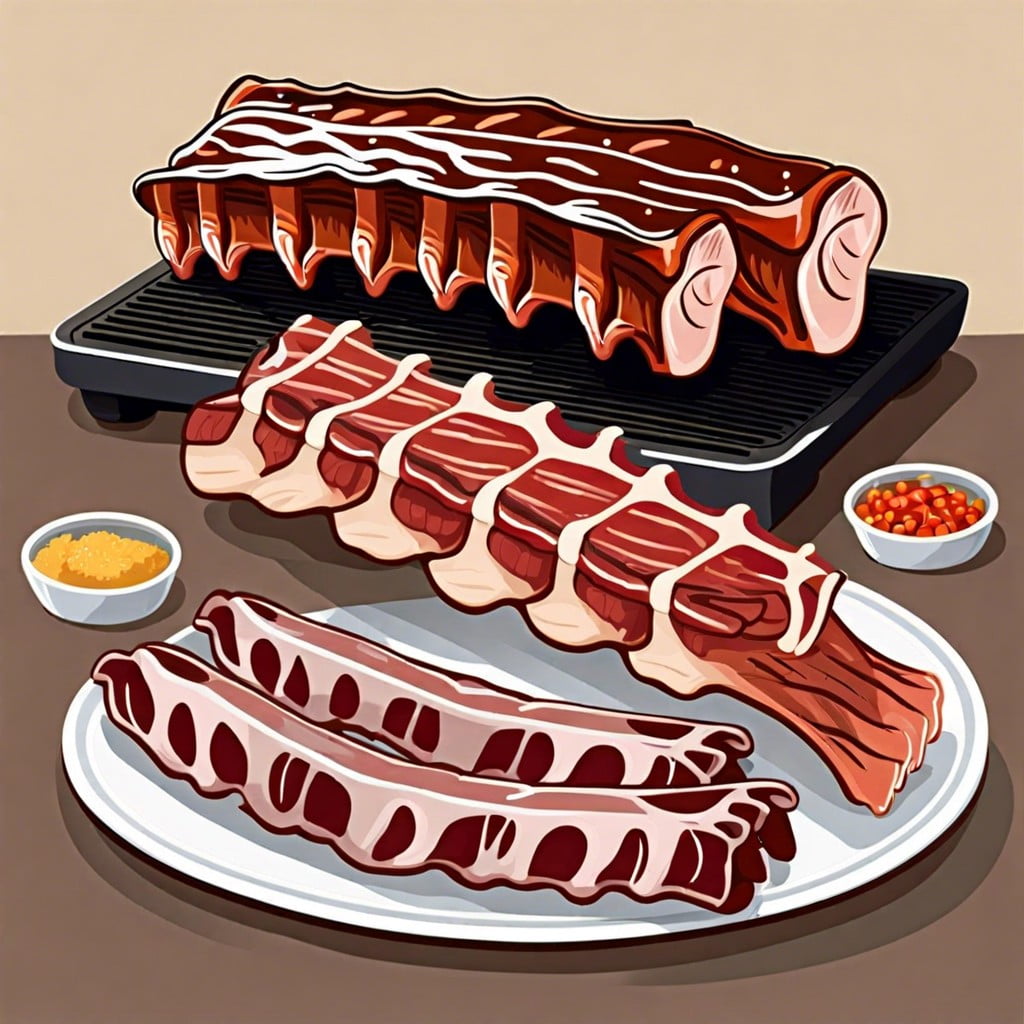This article offers a step-by-step guide on grilling ribs to achieve that perfect balance of flavor and tenderness.
Key takeaways:
- Choose the right type of ribs for grilling.
- Prepare the ribs by removing the membrane and applying a dry rub.
- Use the 3-2-1 method for perfect smoked ribs.
- Check doneness using the bend test, toothpick test, and internal temperature.
- Allow the ribs to rest after grilling for maximum flavor and tenderness.
Choosing Ribs for the Grill

When selecting ribs, identify the type best suited for grilling. Baby back ribs are leaner and smaller in size, making them quick to grill, while St. Louis-style ribs are flatter, which can help them cook more evenly. Spare ribs are meatier and contain more fat, which can result in juicier, more flavorful meat after grilling but will require a longer cooking time.
Look for meat that has a good marbling of fat — this ensures the ribs will be flavorful and tender once cooked. The presence of the meat between the bones, known as the intercostal meat, is also an indicator of quality; the more, the better.
Pre-packaged ribs often come with a membrane attached to the bone-side of the ribs that should be removed prior to grilling because it becomes tough when cooked and can hinder flavor absorption. Use a paper towel to grip the membrane and pull it off in one piece.
If possible, purchase ribs from a reputable butcher. They can provide insight into the source of the ribs and often offer higher-quality cuts than standard grocery stores. They may even trim the ribs for you, saving preparation time.
Lastly, keep in mind the number of people you’re serving. A full rack of baby back ribs should feed about two people, so adjust your purchase accordingly. Remember, it’s better to have a little too much than to leave your guests hungry.
Preparing the Ribs for Grilling
Before exposing ribs to the high heat of the grill, they require proper preparation to ensure the best flavor and texture. Start by removing the membrane on the bone side; this tough layer impedes smoke and seasoning penetration. Gently slide a butter knife under the membrane at one rib end, lift, and peel it away in one piece if possible. Next, pat the meat dry with paper towels.
Apply a generous layer of dry rub, massaging it into the meat for a flavor-packed crust. When preparing your rib rack, remember the drier the rub to start, the better it will adhere. If you prefer a marinade or a wet rub, give it ample time to soak—ideally hours, but at least 30 minutes to infuse the ribs with moisture and flavor.
Lastly, let the ribs reach room temperature before placing them on the grill; this promotes even cooking and reduces grilling time. These steps serve as critical foundations for achieving succulence and depth of flavor once the ribs hit the grill.
The 3-2-1 Method of Grilling Ribs
The 3-2-1 method is a time-tested technique structured to imbue ribs with the perfect balance of smoke, flavor, and tenderness. This process involves three distinct stages of cooking:
1. First Three Hours (3): Begin by smoking the ribs bone-side down at a low temperature around 225°F. This slow pace allows for a deep smoke infusion without charring the exterior.
2. Next Two Hours (2): After the initial smoking phase, tightly wrap the racks in aluminum foil along with a splash of apple juice or your choice of liquid. This creates a steaming effect within the foil, ensuring the meat becomes tender while absorbing additional flavors.
3. Final Hour (1): To finish, remove the ribs from the foil and return them to the grill. In this last hour, apply sauces if desired, which will caramelize and create a sticky exterior. Adjust the grill temperature slightly higher for desired glaze.
It’s crucial to maintain consistent heat during each phase and to resist the urge to peek, as this can disrupt the cooking environment. Patience during each step will reward you with fall-off-the-bone ribs.
Checking Doneness of Grilled Ribs
Ensuring your ribs have reached the perfect point of doneness hinges on a few techniques that go beyond just time on the grill. First, the bend test: pick up the ribs with tongs. If they bend easily and the meat starts to crack on the surface, they’re likely done.
The toothpick test is another reliable method. Insert a toothpick into the meat between the bones; it should slide in with minimal resistance.
Lastly, internal temperature is a key indicator. Aim for between 190°F to 205°F – this range signifies that the connective tissue has broken down sufficiently to yield tender, juicy ribs.
Keep in mind, these methods are more reliable than solely relying on grilling time, which can vary.
Resting the Ribs After Grilling
Once off the grill, the importance of patience comes into play. Allowing the ribs to rest for at least 10 minutes serves a dual purpose: it keeps the juices from running out, ensuring moist, succulent meat while giving the fibers time to relax, enhancing tenderness.
During this period, the residual heat continues to work, allowing the internal temperature to redistribute and settle. Foil can be used to tent the ribs, aiding in heat retention for a consistent rest period. Consider the resting phase an integral component of the rib grilling process to unlock the full potential of flavor and texture in your finished product.

